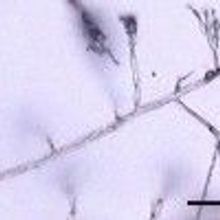Penicillin

Introduction to Bioprocessing
Amielle Moreno, PhD | May 8, 2024 | 7 min read
Bioprocessing employs the transformative power of biochemistry to drive sustainable production and pharmaceutical development.

Deleting a Gene Quells a Pesky Cheese-Destroying Fungus
Natalia Mesa, PhD | Jun 30, 2023 | 3 min read
Fungi disrupt microbial communities on cheese by making antibiotics.

Crystal-Clear Penicillin, 1945
Brittany McWilliams | Apr 3, 2023 | 4 min read
Political activist and Nobel winner Dorothy Crowfoot Hodgkin pioneered X-ray crystallography to discover the molecular structures of penicillin and insulin.

Barbara Low, Trailblazing Woman in X-Ray Crystallography, Dies
Carolyn Wilke | Mar 15, 2019 | 2 min read
The former Columbia University professor’s early work helped illuminate the structure of penicillin, allowing chemists to make variants and broaden the scope of antibiotic treatments.

How Bacteria Eat Penicillin
Shawna Williams | Apr 30, 2018 | 3 min read
Scientists work out the specific genes and biochemical steps required for digesting the very drugs designed to kill microbes.

Image of the Day: Fungal Forms
The Scientist | Apr 19, 2017 | 1 min read
By sequencing and analyzing the genomes of more than 20 species of Penicillium fungi, researches uncovered genes encoding for numerous bioactive compounds, including antibiotics.

Secrets from Neanderthal Tooth Plaque
Jef Akst | Mar 9, 2017 | 2 min read
Ancient hominins in northern Spain ate mushrooms, pine nuts, and moss, and may have used Penicillium mold and other natural products to sooth toothache pain.

Sex and Drugs
Kerry Grens | Jul 1, 2014 | 3 min read
Did 20th-century pharmaceutical and technological advances shape modern sexual behaviors?

Old Ocean Mold
Beth Marie Mole | Dec 12, 2012 | 1 min read
Fungi in 100 million year-old seafloor sediments could possess novel antibiotics.
The Discovery of Penicillin, circa 1928
Cristina Luiggi | Sep 1, 2010 | 2 min read
The drug may very well be one of mankind’s greatest discoveries.
